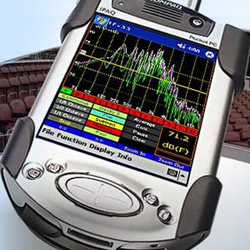
To make any analyzer truly useful in achieving show-to-show tonal consistency, there has to be a way to determine and store a desirable curve. With a bit of attention to the analyzer, it should become obvious that the best sounding shows will tend look a certain way. (And be sure to use a very slow release time on the analyzer).
Typically this “curve” shows up as an angled line gently sloping downward from left to right, at a rate somewhere between 1 dB and 3 dB per octave. For a good starting point, try a straight diagonal line starting at the top of the screen at 20 Hz and ending 20 dB down at 20 kHz. It doesn’t really matter how the curve is saved/stored – RTAs allow curves to be stored and shown, others don’t.
An easy “recall” method I’ve come up with is “ultra-high tech.” Stick a piece of clear tape to the analyzer screen, and use a thin indelible marker (“Sharpie”) to draw your line. Trace a show that really sounded good. Or, as I’ve done when I don’t have my personal Sound Technology RTA 4000 (or even clear tape), peel a long thread from a roll of gaff tape and stick it to the screen.
Keep in mind that I’m not telling you what’s absolutely “right” and/ or “wrong,” or what a curve should look like; but rather, focusing on the tools to consistently recreate the desired sound. When in doubt, cheat. Use the answers from yesterday!
Relatively The Same
A third reference point is the mechanical position of the console knobs. Assuming the system is tuned so that the reference CD sounds correct in the ” super accurate” headphones; similar mics are being used from the previous show; and the band gear is somewhat similar, then the console EQ knob positions should be in relatively the same spot regardless of the venue or system type.
This may sound like a stretch, but think about it. There’s no real reason for the console knobs to radically change from day to day, particularly if the system/room combinations are similar. I realized this when doing a live recording of a band I’ve mixed for many years. While in the recording truck, I noticed that the console EQ knobs were nearly identical to the settings I use live.
I then noticed, over the course of many shows, that when my console EQ knobs varied more than slightly from those settings, it was because the system was EQ’d poorly. Further, when I played CDs, they also required EQ to sound balanced.
If you find yourself boosting high frequencies on every channel, then most likely your system EQ is too dull or you’re mixing bright. If 2.5 kHz is cut on more than half of the channels, then most likely there’s too much 2.5 kHz in the system EQ. Use this information of how the knobs are positioned to help refine system EQ. Over time, refine the curve.
If you think you’re getting off course, pop in the reference CD mid show if needed (be sure it’s muted in the PA of course) and listen to it on headphones. Do a comparison to your mix during the show. Even with different music or songs, this can provide a good idea of whether the mix is tonally balanced or drifting.
Finally, run a board tape from the left and right mix, pre system EQ. This will show if the system EQ method is working. It’s a checkpoint – the tapes should sound listenable and tonally balanced when compared to a CD on headphones (and, for that matter, on smaller hi-fi systems).
If not, make the adjustments in the system EQ to compensate at the next show, and remember, a dull tape means the system EQ is too bright, and vise versa.
The key is to use the tools at your disposal to help keep you on track. I’ve seen many a great engineer scrambling for a mix at festivals. I’ve seen tour after tour come through where you can tell how long the sound crew has been on the road by how hard the power amplifiers for the high-frequency two-inch drivers are clipping.
With a bit of thought and self-control, each and every mix can be made to sound a certain way, regardless of how honest our ears might be at a given time. Now, actually mixing the show – that’s a whole different deal!
Dave Rat is the co-founder and owner of Rat Sound, a leading sound reinforcement company based in Southern California.
